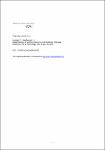Epidemiology of vertigo, migraine and vestibular migraine
Lempert, Thomas
Neuhauser, Hannelore
Both migraine and vertigo are common in the general population with lifetime prevalences of about 16 % for migraine and 7 % for vertigo. Therefore, a concurrence of the two conditions can be expected in about 1.1 % of the general population by chance alone. However, recent epidemiological evidence suggests that the actual comorbidity is higher, namely 3.2 %. This can be explained by the fact that several dizziness and vertigo syndromes occur more frequently in migraineurs than in controls including benign paroxysmal positional vertigo, Meniere’s disease, motion sickness, cerebellar disorders and anxiety syndromes which may present with dizziness. In addition, there is increasing recognition of a syndrome called vestibular migraine (VM), which is vertigo directly caused by migraine. VM affects more than 1 % of the general population, about 10 % of patients in dizziness clinics and at least 9 % of patients in migraine clinics. Clinically, VM presents with attacks of spontaneous or positional vertigo lasting seconds to days. Migrainous accompaniments such as headache, phonophobia, photophobia or auras are common but not mandatory. Cochlear symptoms may be associated but are mostly mild and non-progressive. During acute attacks one may find central spontaneous or positional nystagmus and, less commonly, unilateral vestibular hypofunction. In the symptom-free interval, vestibular testing adds little to the diagnosis as findings are mostly minor and non-specific. In the absence of controlled studies, treatment of VM is adopted from the migraine sphere comprising avoidance of triggers, stress management as well as pharmacotherapy for acute attacks and prophylaxis.
Dateien zu dieser Publikation
Keine Lizenzangabe
Verwandte Publikationen
Anzeige der Publikationen mit ähnlichem Titel, Autor, Urheber und Thema.
-
2009-10-15ZeitschriftenartikelVertigo: Epidemiologic Aspects Neuhauser, Hannelore; Lempert, ThomasVertigo is a frequent symptom in the general population with a 12-month prevalence of 5% and an incidence of 1.4% in adults. Its prevalence rises with age and is about two to three times higher in women than in men. The ...
-
2000-06-01ZeitschriftenartikelEpidemiologie des Schmerzes – Ergebnisse des Bundes- Gesundheitssurveys 1998 Bellach, Bärbel-Maria; Ellert, Ute; Radoschewski, M.Schmerz hat als weit verbreitete Gesundheitsstörung nicht nur Konsequenzen für die Lebensqualität des einzelnen akut oder chronisch Schmerzkranken, sondern stellt darüber hinaus Anforderungen an das Gesundheitssystem. Die ...
-
2014-06-21ZeitschriftenartikelChronische Erkrankungen und impfpräventable Infektionserkrankungen bei Kindern und Jugendlichen in Deutschland Ergebnisse der KiGGS-Studie – Erste Folgebefragung (KiGGS Welle 1)Neuhauser, Hannelore; Poethko-Müller, ChristinaDie Gesundheit von Kindern und Jugendlichen in Deutschland konnte erstmals durch den Kinder- und Jugendgesundheitssurvey KiGGS 2003 bis 2006 umfassend untersucht werden. Die erste Folgebefragung der KiGGS-Studie (KiGGS ...

